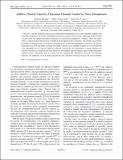| dc.contributor.author | Zhuang, Quntao | |
| dc.contributor.author | Zhu, Elton | |
| dc.contributor.author | Shor, Peter Williston | |
| dc.date.accessioned | 2017-06-13T18:14:23Z | |
| dc.date.available | 2017-06-13T18:14:23Z | |
| dc.date.issued | 2017-05 | |
| dc.date.submitted | 2016-10 | |
| dc.identifier.issn | 0031-9007 | |
| dc.identifier.issn | 1079-7114 | |
| dc.identifier.uri | http://hdl.handle.net/1721.1/109828 | |
| dc.description.abstract | We give a capacity formula for the classical information transmission over a noisy quantum channel, with separable encoding by the sender and limited resources provided by the receiver’s preshared ancilla. Instead of a pure state, we consider the signal-ancilla pair in a mixed state, purified by a “witness.” Thus, the signal-witness correlation limits the resource available from the signal-ancilla correlation. Our formula characterizes the utility of different forms of resources, including noisy or limited entanglement assistance, for classical communication. With separable encoding, the sender’s signals across multiple channel uses are still allowed to be entangled, yet our capacity formula is additive. In particular, for generalized covariant channels, our capacity formula has a simple closed form. Moreover, our additive capacity formula upper bounds the general coherent attack’s information gain in various two-way quantum key distribution protocols. For Gaussian protocols, the additivity of the formula indicates that the collective Gaussian attack is the most powerful. | en_US |
| dc.description.sponsorship | United States. Air Force. Office of Scientific Research (Grant FA9550-14-1-0052) | en_US |
| dc.description.sponsorship | Massachusetts Institute of Technology. Research Laboratory of Electronics (Claude E. Shannon Fellowship) | en_US |
| dc.description.sponsorship | National Science Foundation (U.S.) (Grant CCF-1525130) | en_US |
| dc.description.sponsorship | National Science Foundation (U.S.) (Center for Science of Information. Grant CCF0-939370) | en_US |
| dc.publisher | American Physical Society | en_US |
| dc.relation.isversionof | http://dx.doi.org/10.1103/PhysRevLett.118.200503 | en_US |
| dc.rights | Article is made available in accordance with the publisher's policy and may be subject to US copyright law. Please refer to the publisher's site for terms of use. | en_US |
| dc.source | American Physical Society | en_US |
| dc.title | Additive Classical Capacity of Quantum Channels Assisted by Noisy Entanglement | en_US |
| dc.type | Article | en_US |
| dc.identifier.citation | Zhuang, Quntao, Elton Yechao Zhu, and Peter W. Shor. “Additive Classical Capacity of Quantum Channels Assisted by Noisy Entanglement.” Physical Review Letters 118.20 (2017): n. pag. © 2017 American Physical Society | en_US |
| dc.contributor.department | Massachusetts Institute of Technology. Center for Theoretical Physics | en_US |
| dc.contributor.department | Massachusetts Institute of Technology. Department of Mathematics | en_US |
| dc.contributor.department | Massachusetts Institute of Technology. Department of Physics | en_US |
| dc.contributor.department | Massachusetts Institute of Technology. Research Laboratory of Electronics | en_US |
| dc.contributor.mitauthor | Zhuang, Quntao | |
| dc.contributor.mitauthor | Zhu, Elton | |
| dc.contributor.mitauthor | Shor, Peter Williston | |
| dc.relation.journal | Physical Review Letters | en_US |
| dc.eprint.version | Final published version | en_US |
| dc.type.uri | http://purl.org/eprint/type/JournalArticle | en_US |
| eprint.status | http://purl.org/eprint/status/PeerReviewed | en_US |
| dc.date.updated | 2017-05-19T22:00:04Z | |
| dc.language.rfc3066 | en | |
| dc.rights.holder | American Physical Society | |
| dspace.orderedauthors | Zhuang, Quntao; Zhu, Elton Yechao; Shor, Peter W. | en_US |
| dspace.embargo.terms | N | en_US |
| dc.identifier.orcid | https://orcid.org/0000-0002-9554-3846 | |
| dc.identifier.orcid | https://orcid.org/0000-0002-4497-2093 | |
| dc.identifier.orcid | https://orcid.org/0000-0003-4626-5648 | |
| mit.license | PUBLISHER_POLICY | en_US |
